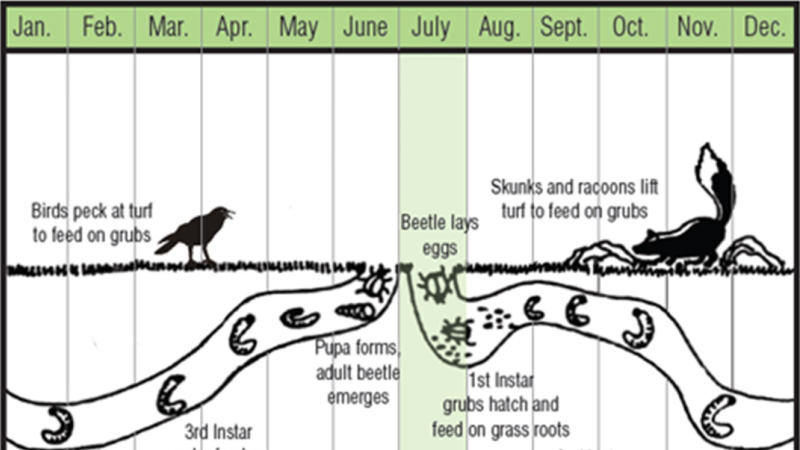Our subsidized Nematode Program has been retired due to low participation. While nematodes are still available at GardenWorks, Burnaby residents are no longer eligible for a 50% discount .
New biological products are now available at local home and garden supply centres. These products are less water intensive than nematode application, have a wider application window and are easier to apply.
Chafer Beetles - a persistent pest
The European chafer (Rhizotrogus majalis) is a turf pest that arrived in New Westminster more than 20 years ago. Since that time it's moved through Burnaby and other Lower Mainland communities, destroying lawn turf.
Chafer beetles emerge from lawns and lay eggs, which hatch into grubs that feed on grass and may move into vegetable patches to feed on other plants if food is scarce. The damage this causes–slow growth and yellow patches–is made worse by the visible damage created when skunks, birds and raccoons pull back your lawn to get at a meal of grubs.
Life cycle of the chafer
The European chafer completes its life cycle in one year. Adult chafers (beetles) swarm in mating flights on warm evenings in June and July. They'll usually fly to tall, vertical structures to mate. However, this isn't the time when they damage your lawn.
The mated females return to grassy areas to lay eggs in the soil. Eggs hatch in June to early August. The resulting grubs then begin feeding on the fibrous roots of grass, while birds and other animals tear at the grass turf to eat the newly hatched grubs.
How to protect your lawn
The European Chafer is an invasive pest with few natural predators to control its population. It's here to stay, but with healthy lawn care practices, alternative groundcovers and biological treatment, you can control the damage this pest causes on your residential property.
Treatment & Control Options
The soil beneath your grass can become very compacted. In early spring, use an aerator to punch 3-inch deep holes throughout your lawn, loosening the soil and allowing for better air circulation and absorption of water and nutrients. Water your grass thoroughly but less often to get the roots growing deeper into the soil. Use fertilizer in May when shoot growth begins–it peaks in June/July and again in September. Reuse grass clippings or compost them to add more nutrients to your grass.
Raise your mowing height to 6 to 9 cm (from 2.5 to 3 inches). Chafer beetles prefer to lay their eggs on closely cropped lawns. Raising your lawnmower grass blades will also help to protect the soil surface from water loss during the summer, and encourage deeper root growth.
You can consider alternatives to grass There are many very attractive varieties of groundcover plants that cover an area just the way grass does. They require little maintenance, especially if you add paving stones for high-traffic areas. The other alternative is moving towards a more mixed-grass lawn that includes a variety of fescue grasses, Dutch white clover or micro clover that are more resistant to Chafer beetle infestations.
Biological solutions
When combined with healthy lawn care practices, Chafer beetle infestations can be treated naturally.
BTG is a relatively new microbial product that suppresses pests like the European Chafer beetle. Its active ingredient–Bacillus thuringiensis galleriae– kills larvae or beetles when they eat it. Commercial products BeetleGONE!® and GrubGONE!® must be applied by a commercial applicator. A domestic product, Grub B Gone®, is available at home and garden supply stores for homeowners to purchase. Since the treatment isn't water-intensive, you don't need and won't qualify for a lawn watering exemption permit. Like nematodes, BTG products aren't harmful to people, pets or wildlife.
Increasingly-common hotter summers are making nematodes a less effective chafer treatment. Nematodes must be applied during the warmest part of the year, and can only live in a damp environment--which is why users are eligible for a lawn watering exemption permit. Even with extra watering, extreme heat is nearly impossible for nematodes to survive. Managing our water resources responsibly in the dry summer months is one of our climate action priorities, and by issuing fewer exemption permits, we'll be doing our part to preserve the drinking water in our reservoirs.
Nematode application
There are 2 nematode application methods that work best–a watering can or a hose end sprayer that's made specifically for nematode application. Follow the instructions on the nematode package to ensure best results for your turf treatment.
If you need a lawn water exemption permit you can apply for it through our online portal.
What is the City doing?
Since our European Chafer Beetle Management Plan was approved in 2006, we've taken action to control the spread of the beetle. Our campaigns have included:
- public workshops on healthy lawn care
- surveillance and treatment on public lands
- our now-retired nematode subsidy program
With consistent care and the help of our residents, Burnaby's European Chafer population has declined significantly from its peak.
We're continuing yearly treatment and monitoring of the European Chafer in priority areas such as parks, greenways and main arterial boulevards to make sure this pesky invasive species keeps declining.
